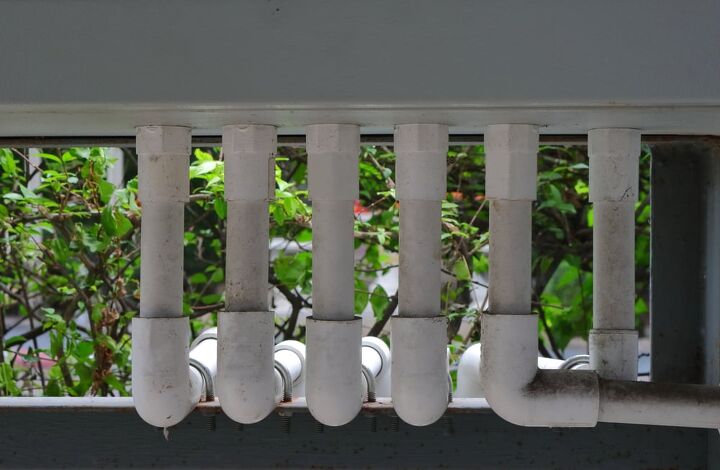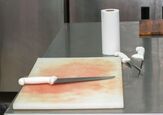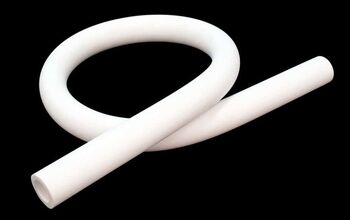How To Protect PVC Pipe From Sunlight (Quickly & Easily!)

The sun is a powerful force of nature. It can cause a lot of damage if we fail to take precautions against it. Even elements of your home such as PVC pipes are not immune from the sun’s powerful ultraviolet rays.
Leave the PVC pipes exposed to the sun and they will weaken significantly. It’s your job as the homeowner to keep them better protected.
You can effectively protect PVC pipes from sunlight by coating them with PVC primer and water-based latex paint. Clean the surface of the PVC pipe thoroughly before applying the primer. Once the primer has dried, apply an even layer of light-colored paint to create a protective barrier over the PVC pipe.
The PVC pipes in your septic system need to be protected properly from outside forces such as the sun. Find out how to do exactly that by continuing with this article.
Do You Need to Hire a Plumber?
Get free, zero-commitment quotes from pro contractors near you.

How Sunlight Affects PVC
You may be wondering why it’s so important to keep PVC pipes protected from the rays of the sun. After all, those pipes deal with other nasty substances so sunlight shouldn’t be much of an issue.
While it’s true that PVC does a great job of holding up to sewage, sunlight is another matter. Let’s talk about the ways UV rays can damage PVC in this section.
The PVC Pipes Will Become Discolored
Some of the molecules in the PVC change after they are exposed to ultraviolet rays long enough. They start to feature a different structure while also taking on a different look. That change in structure is what causes the PVC’s appearance to change. Notably, the discoloration doesn’t happen right away.
The transformation begins with the PVC losing some of its luster. Its appearance starts to look dull and faded. The loss of the shine becomes even more pronounced as the PVC appears chalky in appearance.
Discoloration sets in after those earlier symptoms have popped up. The discoloration will also progress in stages. At first, it will look like the pipes have a yellowish hue before they turn brown and then black in color.
The Impact Strength of the PVP Pipes Will Deteriorate
Arguably the more significant side effect of leaving PVC exposed to the sun too long is the loss of impact strength. For those who may be unaware, impact strength refers to a material’s capability to endure a blow. Basically, a material with a good amount of impact strength can better withstand external forces.
Impact strength matters a great deal because of how PVC pipes are used. Since they sometimes have to support weight, you need the PVC pipes to be nice and sturdy.
It’s difficult for the PVC pipes to provide that stability if they lack the requisite impact strength. What that means is that your septic system is at greater risk of sustaining damage if the pipes aren’t adequately protected.
Protecting Your PVC Pipes from Sunlight
Keeping the PVC pipes underground will shield them from sunlight, but that setup is not possible in all situations. If your PVC pipes have to be installed above ground, you need to protect them. Following the steps detailed in this section will help greatly in that regard.
Step 1: Prepare the Items Needed to Treat the PVC Pipes
Special pieces of hardware are required if you want to strengthen PVC pipes. If your goal is to protect them from UV rays though, you will need some chemicals.
You have to start with some paint. Choose water-based paint for this job. Water-based paint is preferred here because the oil and solvent-based variants will have a harder time sticking to the PVC surface.
Make sure you pick up latex paint as well. Latex paint offers a good amount of resistance to cracking and fading. That’s exactly what you need covering the PVC pipes. As for the color of the paint, stick to the lighter variants. Dark colors absorb more ultraviolet rays and you want to avoid that.
Once you’ve chosen the paint, pick up some PVC primer and some naphtha-based fluid too. Also remember to get some gloves, rags, and paintbrushes.
Step 2: Create a Workstation Outdoors
The fumes coming from the paint, primer, and naphtha-based fluid can be harmful. You shouldn’t expose yourself to those vapors for any length of time.
To avoid prolonged exposure to those fumes, create a workstation outside. A table with nothing else on it but your tools will be good enough to serve as a workstation.
Step 3: Clean the PVC Pipes with Water
Grab one of the rags and soak with a bit of water. Now, use that damp rag to wipe the PVC pipes clean. Try to get rid of as much debris as you can while doing this.
Step 4: Clean the PVC Pipes with the Naphtha-Based Fluid
Next up, you must clean the PVC pipes using the naphtha-based fluid. The surface of the PVC pipes may be coated with chemicals that could prevent the paint from sticking well. You have to get rid of them using the naphtha-based fluid.
Put on your gloves then soak a rag with some of the naphtha-based fluid. Go ahead and use that rag now to clean the surface you’ll be painting. Make sure you remove anything that could get in the way of the water-based latex paint.
Step 5: Rinse the PVC Pipes
Use some warm water to rinse the pipes clean of the naphtha-based fluid. You don’t want any residue of that liquid on the surface so rinse thoroughly.
Step 6: Allow the PVC Pipes to Dry
You should now let the PVC pipes dry so the primer and paint stick without issue later on. Letting the surface air dry will suffice, but you can wipe it down with a dry rag if you want to.
Step 7: Apply the PVC Primer
Go ahead and apply the PVC primer now. Use one of the clean paintbrushes to apply an even coating of the PVC primer. Let the surface air dry again after you’re done applying the primer.
Step 8: Paint the PVC Pipes
All that you have to do now is to paint the PVC pipes. Work carefully to create an even layer of the latex paint over the surface.
One layer of paint will provide protection, but you can add more if you want. Just remember to let the first layer of paint dry first before adding the next coating.
Are There Other Ways to Protect the PVC Pipes from Sunlight?
If you don’t want to paint the PVC pipes, you can try other ways of protecting them. The easiest way to keep the pipes protected involves purchasing a tarp.
You can place a tarp over the exposed pipes and secure it in place to ensure it always provides protection. Don’t use a black tarp though because that will concentrate too much heat on the pipes.
A burlap covering can also work in a pinch. Cut up some burlap sacks and use them to provide temporary cover for the PVC surfaces. Other opaque coverings can work as well. Install those opaque coverings over the pipes to keep the harmful UV rays at bay.
Do You Need to Hire a Plumber?
Get free, zero-commitment quotes from pro contractors near you.

Related Questions
Can Other Factors Amplify the Effect of Sunlight on the PVC Pipes?
We’ve already established that sunlight can be bad for PVC pipes. It is also worth noting that the effects of the UV rays can be amplified by other factors. Factors that are going to play a role include how long the PVC pipe is exposed and the weather conditions. The characteristics of the pipe itself matter greatly.The specific compounds used to make the PVC pipe can affect how well it holds up to exposure. The size of the pipe is also something you have to keep in mind.
What Size PVC Pipes Hold Up Better to Sunlight?
If you’re worried about how the PVC pipes will withstand sunlight exposure, you may want to purchase schedule 80 pipes. Schedule 80 pipes have thicker walls. That means they won’t lose much impact strength even after being exposed to the sun.You should know though that schedule 80 pipes have narrower openings. If you think those narrower openings may clog your septic system, you may want to use schedule 40 pipes instead.
More Related Guides

Gary Evans is passionate about home improvement. He loves finding out how to make improvements in the easiest, most practical, and most affordable ways. Upgrading his home kitchen is one of his ongoing hobbies. Gary is also a long-time content creator and enjoys spending his free time tending to his hydroponic vegetable garden.
More by Gary Evans













![10 Best Electric Lawn Mowers - [2022 Reviews & Top Rated Models]](https://cdn-fastly.upgradedhome.com/media/2023/07/31/9070486/10-best-electric-lawn-mowers-2022-reviews-top-rated-models.jpg?size=350x220)
![10 Best Electric Pressure Washers – [2022 Reviews & Guide]](https://cdn-fastly.upgradedhome.com/media/2023/07/31/9070600/10-best-electric-pressure-washers-2022-reviews-guide.jpg?size=350x220)












